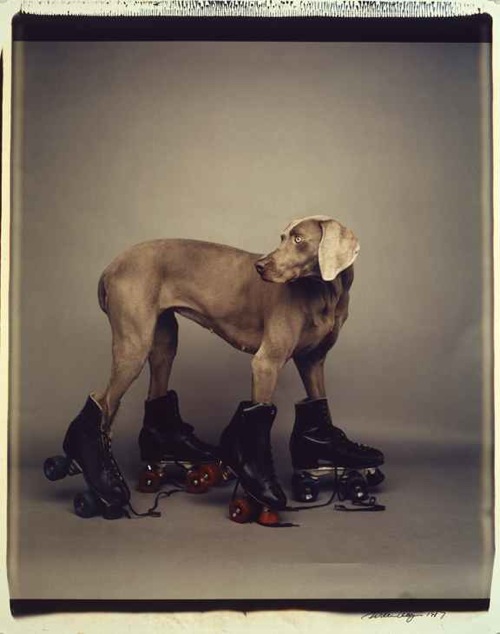There are people who own dogs and love dogs. And then there are those dog people--the ones who go a little overboard. These are the people who, as the artist William Wegman told me recently, "are so doggy, everything they do is sort of a dog thing."
It might come as a surprise that Wegman, who is and will forever be best known for his droll photographs of Weimaraners, does not consider himself very doggy. But he insisted as much when I interviewed him recently for an article in the September issue of Smithsonian magazine. The piece tells the story behind a 1986 Wegman image called "Roller Rover," in which his beloved cinnamon-gray Weimaraner Fay Wray is seen perched atop two pairs of roller skates. (Four legs, four skates.) The picture, now 25 years old, remains a definitive example of the work that has made Wegman one of the world's most widely-known conceptual artists. It combines comedy, surrealism, and anthropomorphism at will and always with a purpose. His pictures puncture the regal bearing of the beautiful dogs by surrounding the animals with the absurd artifacts of everyday human life. "A noble nature is diminished by platitude, a dignified mien degraded by unworthy aspiration," in the worlds of art critic Mark Stevens. Wegman is having some fun, but it's really at our expense, not the dog's. The dog is just there to help us enjoy being shown up for what we are.

"Roller Rover," 1986, Courtesy William Wegman
And enjoy it we do--Wegman, 67, has become a both a cultural and commercial juggernaut whose work has been featured in museums and on Saturday Night Live and Sesame Street. He also has a Weimaraner-motif fabric line, jigsaw puzzles featuring his Weimaraner images, and more than 20 books of Weimaraner photographs. He burst on the scene in the late 1960s, after a studying at the Massachusetts College of Art (Wegman, born in 1943 in Holyoke, Massachusetts, said once that he almost didn't attend the College of Art because it didn't have a hockey team, a sport he still plays in an adult league at the Chelsea Piers sport complex in Manhattan.)
The late '60s were the heyday of conceptual art. "I think the artists who came out of the 1960s wanted to find other ventures than galleries and museums, for different reasons," he told me. "It could have been Marxim, it could have been commerce--I don't know." He has said that his influences include the artists Bruce Nauman, Allen Ruppersberg, and Ed Ruscha, but he's also made a point of mentioning his adoration of the comedians Rob Elliott and Ray Goulding, whose arid satire inspired him. "Their humor was about just going about the business of following through with the ordinary," he told me.
His breakthrough came after he moved to Los Angeles in the early 1970s and picked up a male Weimaraner for $25. Wegman came to see the comic and conceptual possibilities of he dog, whom he named Man Ray after the surrealist photographer. Featured in a number of videos (Man Ray quizzically listening to Wegman read a school report card) and photographs (Man Ray dusted with flour), the charismatic dog became an icon for the alienated Watergate era.
When Man Ray died 1981, Wegman assumed he was through with dog art--until he went to Memphis, Tennessee to give a lecture in 1985. There, a dog breeder who assumed he was bereft from the loss of Man Ray made him a gift of a female Weimaner puppy she called Cinnamon Girl. Wegman took her home to New York and renamed her Fay Wray, after the glamorous star of King Kong. "My first art dealer, Holly Solomon, said Fay was actually kind of suburban," said Wegman. "I disagreed. I thought she was very elegant and kind of lofty, and also kind of evil."
Wegman said that as a puppy in the big city, Fay Wray was shy, but one day when she was a year old she told him, in the way that dogs tell things to the people who let them sleep in their beds, that she was ready to work. "As I recall, she said to me, "I didn't come all the way from Tennessee to New York just to lie around in your studio," said Wegman. Shortly thereafter, he took her to Cambridge, Massachusetts to create a number of images with the refrigerator-sized Polaroid 20x24 camera.
These days, Wegman's work continues with a dog named Penny, who is the great-great-great-great granddaughter of Fay Wray, who died in 1995 after a full life serving the demands of art and commerce. The key to working with the dogs, he told me, is to understand them as dogs--to not become one of those people who are too doggy. "When you see them licking up pizza that someone has run over with their car, you realize there is something different between you and them," he said.
You can read my full interview with Wegman at the Big Picture blog.
Related
Sign up for Peacock to stream NBCU shows.
to stream NBCU shows.